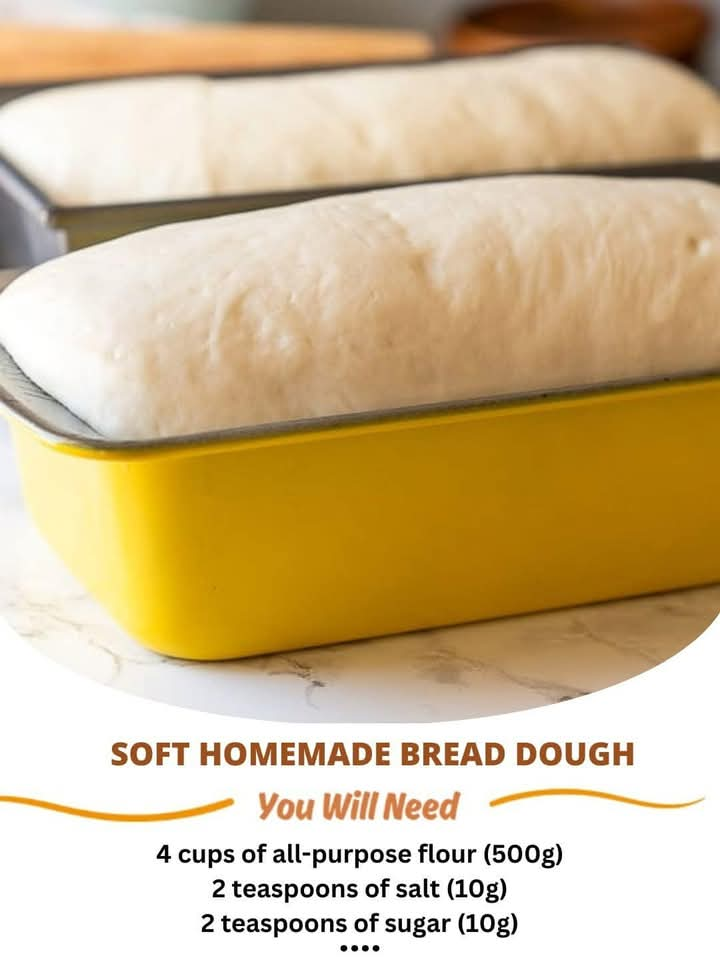Soft Homemade Bread Dough – Fluffy as a Cloud
If you’ve ever dreamed of making the softest, fluffiest homemade bread, this is the perfect recipe for you. With just a few simple ingredients and a little secret trick, you can create a bread that’s as light as air, with a beautifully golden crust and a tender crumb inside.
Why This Bread Is Extra Soft & Fluffy
The secret to making this bread incredibly soft lies in two key techniques:
- Yeast Activation: Letting the yeast bloom with warm water and sugar before mixing it into the flour helps kickstart the fermentation process, ensuring a better rise.
- Double Rise Method: Allowing the dough to rise twice (once in bulk and once after shaping) enhances the gluten structure, making the bread softer and fluffier.
Ingredients
Basic Dough Ingredients:
- 4 cups all-purpose flour (500g) – Can be substituted with bread flour for a chewier texture.
- 2 teaspoons salt (10g) – Enhances flavor and controls yeast growth.
- 2 teaspoons sugar (10g) – Feeds the yeast, promoting fermentation and tenderness.
- 1 ½ tablespoons dry yeast (or 2 tablespoons fresh yeast) (15g dry or 30g fresh) – The key ingredient for rising.
- 1 ½ cups warm water (98°F or 37°C) (350ml) – Helps activate the yeast and hydrates the flour.
Optional for Extra Softness:
- 2 tablespoons vegetable oil or melted butter – Adds richness and helps with softness.
- ¼ cup milk (warm) – Replaces some of the water for a more tender crumb.
- 1 tablespoon honey – A natural sweetener that enhances the dough’s softness.
Step-by-Step Instructions
Step 1: Activate the Yeast
- In a small bowl, combine the yeast, sugar, and half of the warm water. Stir gently and let sit for 5–10 minutes.
- The yeast should become foamy and bubbly. If it doesn’t, the yeast may be expired, and you should start over with fresh yeast.
Step 2: Mix the Dough
- In a large mixing bowl, combine the flour and salt. Stir to distribute evenly.
- Make a well in the center and pour in the activated yeast mixture.
- Add the remaining warm water and mix with a wooden spoon or dough hook (if using a stand mixer) until the dough starts to come together.
Step 3: Knead the Dough
- If kneading by hand: Transfer the dough onto a lightly floured surface and knead for 8–10 minutes, until smooth and elastic. Use the “stretch and fold” technique to develop the gluten.
- If using a stand mixer: Knead with a dough hook on medium speed for 5–7 minutes until the dough is smooth and slightly sticky but pulls away from the sides of the bowl.
Step 4: First Rise (Bulk Fermentation)
- Lightly grease a large bowl with oil or butter and place the dough inside.
- Cover with a damp cloth or plastic wrap and let it rise in a warm, draft-free place for 1 to 1 ½ hours, or until doubled in size.
- A great spot is inside the oven with the light on, or near a slightly warm stovetop.
Step 5: Shape the Dough
- Once doubled in size, punch down the dough gently to release air.
- Transfer it to a lightly floured surface and shape it into a loaf, rolls, or any desired form.
- Place the shaped dough into a greased loaf pan or onto a baking sheet lined with parchment paper.
Step 6: Second Rise (Final Proofing)
- Cover the shaped dough with a clean kitchen towel and let it rise again for 30–45 minutes, until it puffs up nicely.
- This step is crucial for achieving that light, fluffy texture.
Step 7: Bake to Perfection
- Preheat the oven to 375°F (190°C). If you like a shinier crust, brush the top of the dough with an egg wash (1 egg beaten with a little water).
- Bake for 25–30 minutes (for a loaf) or 15–20 minutes (for rolls), until golden brown.
- The bread should sound hollow when tapped on the bottom, which indicates it’s fully baked.
Step 8: Cooling & Serving
- Remove the bread from the oven and let it cool on a wire rack for at least 15–20 minutes before slicing.
- Enjoy warm with butter, jam, or use it for sandwiches!
Tips for Success
- For extra softness, replace half of the water with warm milk and add 2 tablespoons of melted butter to the dough.
- Want a crispy crust? Bake with a small oven-safe dish of water on the bottom rack for steam.
- Make-ahead option: After the first rise, refrigerate the dough overnight, then let it come to room temperature before shaping and baking.
- Storage: Store in an airtight container at room temperature for up to 3 days, or freeze for longer storage.
Variations & Customizations
- Garlic Herb Bread: Add 1 teaspoon of garlic powder and 1 tablespoon of dried Italian herbs to the dough.
- Cheese Bread: Knead in 1 cup of shredded cheddar or Parmesan before the first rise.
- Sweet Honey Bread: Add 2 tablespoons of honey instead of sugar for a naturally sweet flavor.
- Whole Wheat Version: Substitute half the all-purpose flour with whole wheat flour for a healthier loaf.
Why You’ll Love This Bread
✔ Super soft and fluffy with a perfect rise
✔ Simple ingredients you already have at home
✔ Easy to make with step-by-step instructions
✔ Versatile – enjoy as sandwich bread, dinner rolls, or toast
Now you’re ready to bake the softest, most delicious homemade bread! Would you like a recipe for a butter spread to go with it?
